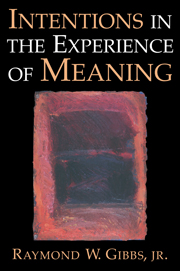Book contents
- Frontmatter
- Contents
- Acknowledgments
- Part I INTRODUCTION
- Part II SEARCHING FOR INTENTIONS
- Chapter 2 INTENTIONS AND INTENTIONAL ACTION
- Chapter 3 MEANING AND COMMUNICATION
- Chapter 4 INFERRING INTENTIONALITY IN EXPERIENCE
- Part III INTENTIONS IN DISCOURSE
- Part IV INTENTIONS IN CRITICISM
- Part V CONCLUSION
- Notes
- Name Index
- Subject Index
Chapter 4 - INFERRING INTENTIONALITY IN EXPERIENCE
Published online by Cambridge University Press: 05 June 2012
- Frontmatter
- Contents
- Acknowledgments
- Part I INTRODUCTION
- Part II SEARCHING FOR INTENTIONS
- Chapter 2 INTENTIONS AND INTENTIONAL ACTION
- Chapter 3 MEANING AND COMMUNICATION
- Chapter 4 INFERRING INTENTIONALITY IN EXPERIENCE
- Part III INTENTIONS IN DISCOURSE
- Part IV INTENTIONS IN CRITICISM
- Part V CONCLUSION
- Notes
- Name Index
- Subject Index
Summary
Put yourself in my shoes for a moment as I recount an experience I had several years ago entering an art exhibition in San Francisco created by Ann Hamilton called Privation and Excesses. Several friends and I walked into the door of a warehouse and entered a large room. On the floor lay a huge rectangular pile of pennies (over 700,000), about five inches in height, arranged systematically in overlapping waves of copper. The pennies were laid on a layer of honey that extended several inches beyond the pennies. A woman sat on a simple wooden chair behind the pennies, staring downward, constantly washing her hands in a basin of honey. Behind the woman to one side there was a wooden pen, the floor covered with hay, containing two live sheep (the smell of the sheep distinctly in the air). On the other side of the woman, also behind her, were two small mechanized mortars and pestles, one slowly grinding up pennies, the other grinding up human teeth.
This clearly was an unusual art installation, to say the least. After walking in silence around the exhibit for several minutes, one of my friends, Ken, came up to me and we had the following conversation:
Ken: What does it mean?
Ray: What do you mean what does it mean?
Ken: Well, the artist must have had some idea as to what all this was supposed to represent or mean. What did she want us to think about when seeing all this?
- Type
- Chapter
- Information
- Intentions in the Experience of Meaning , pp. 69 - 106Publisher: Cambridge University PressPrint publication year: 1999
- 1
- Cited by



